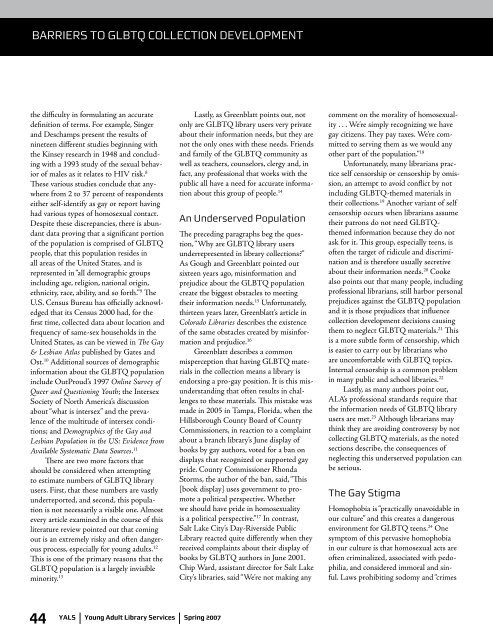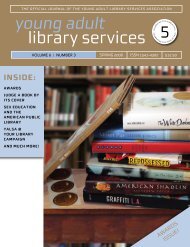Spring 2007 - YALSA - American Library Association
Spring 2007 - YALSA - American Library Association
Spring 2007 - YALSA - American Library Association
You also want an ePaper? Increase the reach of your titles
YUMPU automatically turns print PDFs into web optimized ePapers that Google loves.
arriers to glbtq collection developmentthe difficulty in formulating an accuratedefinition of terms. For example, Singerand Deschamps present the results ofnineteen different studies beginning withthe Kinsey research in 1948 and concludingwith a 1993 study of the sexual behaviorof males as it relates to HIV risk. 8These various studies conclude that anywherefrom 2 to 37 percent of respondentseither self-identify as gay or report havinghad various types of homosexual contact.Despite these discrepancies, there is abundantdata proving that a significant portionof the population is comprised of GLBTQpeople, that this population resides inall areas of the United States, and isrepresented in “all demographic groupsincluding age, religion, national origin,ethnicity, race, ability, and so forth.” 9 TheU.S. Census Bureau has officially acknowledgedthat its Census 2000 had, for thefirst time, collected data about location andfrequency of same-sex households in theUnited States, as can be viewed in The Gay& Lesbian Atlas published by Gates andOst. 10 Additional sources of demographicinformation about the GLBTQ populationinclude OutProud’s 1997 Online Survey ofQueer and Questioning Youth; the IntersexSociety of North America’s discussionabout “what is intersex” and the prevalenceof the multitude of intersex conditions;and Demographics of the Gay andLesbian Population in the US: Evidence fromAvailable Systematic Data Sources. 11There are two more factors thatshould be considered when attemptingto estimate numbers of GLBTQ libraryusers. First, that these numbers are vastlyunderreported, and second, this populationis not necessarily a visible one. Almostevery article examined in the course of thisliterature review pointed out that comingout is an extremely risky and often dangerousprocess, especially for young adults. 12This is one of the primary reasons that theGLBTQ population is a largely invisibleminority. 13Lastly, as Greenblatt points out, notonly are GLBTQ library users very privateabout their information needs, but they arenot the only ones with these needs. Friendsand family of the GLBTQ community aswell as teachers, counselors, clergy and, infact, any professional that works with thepublic all have a need for accurate informationabout this group of people. 14An Underserved PopulationThe preceding paragraphs beg the question,“Why are GLBTQ library usersunderrepresented in library collections?”As Gough and Greenblatt pointed outsixteen years ago, misinformation andprejudice about the GLBTQ populationcreate the biggest obstacles to meetingtheir information needs. 15 Unfortunately,thirteen years later, Greenblatt’s article inColorado Libraries describes the existenceof the same obstacles created by misinformationand prejudice. 16Greenblatt describes a commonmisperception that having GLBTQ materialsin the collection means a library isendorsing a pro-gay position. It is this misunderstandingthat often results in challengesto these materials. This mistake wasmade in 2005 in Tampa, Florida, when theHillsborough County Board of CountyCommissioners, in reaction to a complaintabout a branch library’s June display ofbooks by gay authors, voted for a ban ondisplays that recognized or supported gaypride. County Commissioner RhondaStorms, the author of the ban, said, “This[book display] uses government to promotea political perspective. Whetherwe should have pride in homosexualityis a political perspective.” 17 In contrast,Salt Lake City’s Day-Riverside Public<strong>Library</strong> reacted quite differently when theyreceived complaints about their display ofbooks by GLBTQ authors in June 2001.Chip Ward, assistant director for Salt LakeCity’s libraries, said “We’re not making anycomment on the morality of homosexuality. . . We’re simply recognizing we havegay citizens. They pay taxes. We’re committedto serving them as we would anyother part of the population.” 18Unfortunately, many librarians practiceself censorship or censorship by omission,an attempt to avoid conflict by notincluding GLBTQ-themed materials intheir collections. 19 Another variant of selfcensorship occurs when librarians assumetheir patrons do not need GLBTQthemedinformation because they do notask for it. This group, especially teens, isoften the target of ridicule and discriminationand is therefore usually secretiveabout their information needs. 20 Cookealso points out that many people, includingprofessional librarians, still harbor personalprejudices against the GLBTQ populationand it is those prejudices that influencecollection development decisions causingthem to neglect GLBTQ materials. 21 Thisis a more subtle form of censorship, whichis easier to carry out by librarians whoare uncomfortable with GLBTQ topics.Internal censorship is a common problemin many public and school libraries. 22Lastly, as many authors point out,ALA’s professional standards require thatthe information needs of GLBTQ libraryusers are met. 23 Although librarians maythink they are avoiding controversy by notcollecting GLBTQ materials, as the notedsections describe, the consequences ofneglecting this underserved population canbe serious.The Gay StigmaHomophobia is “practically unavoidable inour culture” and this creates a dangerousenvironment for GLBTQ teens. 24 Onesymptom of this pervasive homophobiain our culture is that homosexual acts areoften criminalized, associated with pedophilia,and considered immoral and sinful.Laws prohibiting sodomy and “crimes44 YALS | Young Adult <strong>Library</strong> Services | <strong>Spring</strong> <strong>2007</strong>









